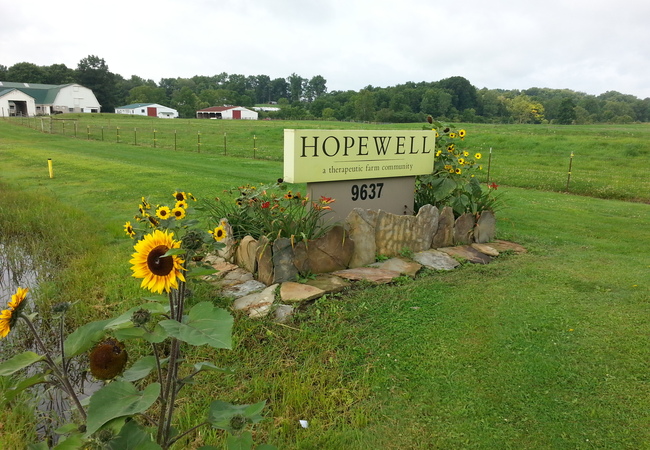September 15, 2025
A Day in the Life: Inside a High Acuity Mental Health Treatment Center on a Farm
By Annie Boyle, LPC
Imagine waking up to the sound of roosters crowing, the smell of fresh hay and grass, and the sight of open fields and trees stretching to the horizon. This is daily life at Hopewell, where clinical care and communal living blend into a therapeutic model that is both structured and restorative.
Morning Meds and Community Breakfast
The day begins early, with residents rising around 7:00 a.m. Morning medication is taken under the supervision of staff, followed by a communal breakfast in the main dining room. Meals often include eggs gathered from the farm’s hens or vegetables from the garden. Beyond nourishment, breakfast doubles as a chance for residents to review the schedule and plan their days.
Chores as Therapeutic Interventions
After breakfast, residents head to morning work crews. On the farm, chores are more than tasks—they are therapeutic interventions. Residents might feed goats and horses, collect eggs, tend to the garden, or help maintain shared spaces. For individuals coping with intense symptoms, the rhythm of farm work offers grounding. Caring for animals fosters responsibility and connection, while repetitive tasks like weeding or sweeping reduce anxiety and open space for mindfulness. By late morning, the community gathers for a community meeting, checking in as a group before lunch. Lunch is then shared by staff and residents. Meals are crafted to provide both nourishment and practice for social skills, gently supported by staff who model communication and encourage connection.
Structure Therapeutic Programming
Midday brings structured group programming. In group settings, residents can utilize the support of the community to engage in development of useful skills and understanding. Some sessions are led by licensed clinicians and focus on evidence-based practices such as Acceptance and Commitment Therapy (ACT), Exposure and Response Prevention (ERP), and Cognitive Behavioral Therapy (CBT). Other groups focus on practical skills. A life skills workshop might cover budgeting or cooking, while expressive arts sessions invite residents to paint, write, or engage in music under the guidance of art and music therapists. Movement is also woven into the program: yoga, nature walks in the woods, or equine-assisted therapy with horses that mirror human emotions and require patience, calm presence, and consistency.
Individual Therapy and Psychiatric Appointments
Between groups, residents attend individual therapy and psychiatric appointments. In sessions, residents are supported in identifying and engaging restorative practices that benefit their overall recovery journey. This might look like creating an exposure hierarchy and being supported in utilizing it on the farm, engaging in EMDR (Eye Movement Desensitization and Reprocessing), zooming in on interpersonal effectiveness, or being given a space to grieve and experience their emotions without judgement. Because the program is high acuity, psychiatrists are closely involved in resident care, adjusting medications as needed and collaborating as a treatment team. This level of oversight provides a safety net that outpatient settings cannot always offer.
Building Self-Connection
Throughout the day, residents also have opportunities for reflection. Some journal under a shady tree, others rest in their rooms, fish in the pond, or hike in the woods. Staff encourage quiet moments as an essential part of the therapeutic process, recognizing that recovery is not only about activity but also about tolerating stillness and building self-connection.
Communal Dinner and Leisure Time
Dinner is another shared meal, with residents and staff reflecting together on the day. Sometimes there are short outings—to the library, a store, or a nearby park—before the farm settles for the night.
As the sun sets, leisure time begins. Residents might play board games, watch movies, or simply enjoy the calm of the countryside. While staff remain vigilant given the high acuity of the program, the atmosphere remains a hybrid of a therapeutic community and a working farm, where healing is interwoven with the rhythms of daily life. Before bed, medications are distributed and by 10:00 p.m., the farm is quiet, with only the sounds of crickets and animals carrying through the night air.
Structure, Connection and Nature
High acuity care requires intensive support, but here that support is softened by sunlight, fresh air, and community. For individuals in crisis, the combination of structure, connection, and nature offers something rare: the chance to heal in an environment that feels alive, hopeful, and grounded. The farm does not replace therapy—it enhances it, reminding each resident that growth is possible and that, like the nature and animals around them, healing unfolds with patience, care, and time.
Back to Blog
